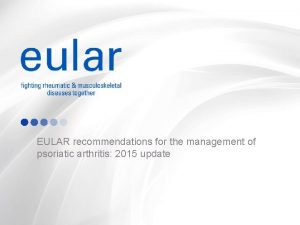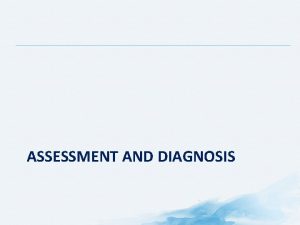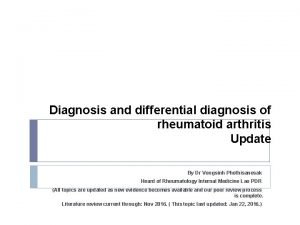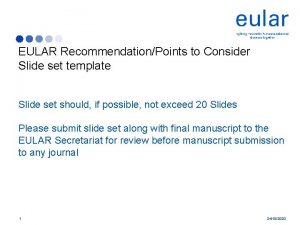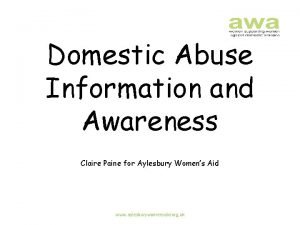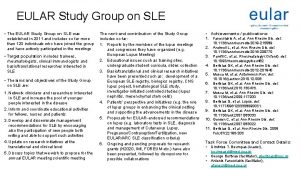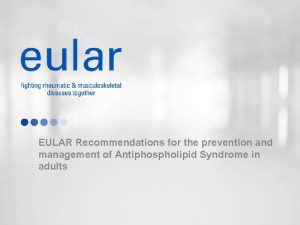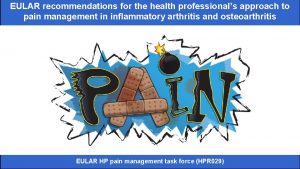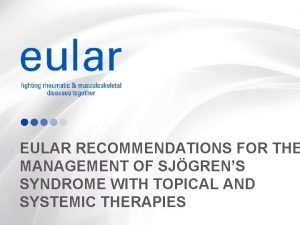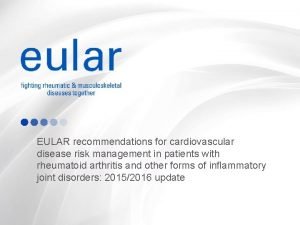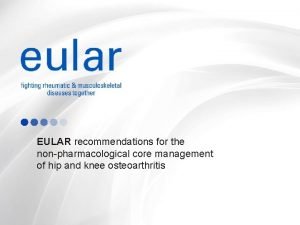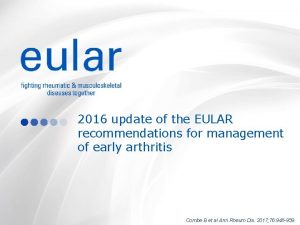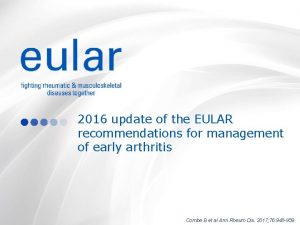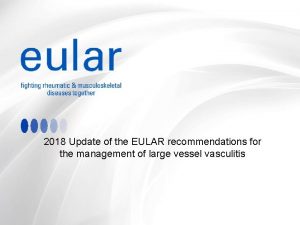EULAR recommendations for womens health and the management

















- Slides: 17

EULAR recommendations for women’s health and the management of family planning, assisted reproduction, pregnancy and menopause in patients with systemic lupus erythematosus and/or antiphospholipid syndrome L Andreoli, G K Bertsias, N Agmon-Levin, S Brown, R Cervera, N Costedoat-Chalumeau, A Doria, R Fischer-Betz, F Forger, M F Moraes-Fontes, M Khamashta, J King, A Lojacono, F Marchiori, PL Meroni, M Mosca, M Motta, M Ostensen, C Pamfil, L Raio, M Schneider, E Svenungsson, M Tektonidou, S Yavuz, D Boumpas, A Tincani Annals of the Rheumatic Diseases 2017; 76: 476 -485

Target population/questions Systemic lupus erythematosus (SLE) and the antiphospholipid syndrome (APS), SLE-associated or primary APS, affect mostly women of childbearing age. The management of reproductive and other women’s health issues may impact on personal relationships and the decision to have children. Object of these recommendations is to cover the unmet needs on women’s health issues and family planning in these young patients. Research questions 1. What is the evidence that the following pre-conception (planned versus unintended pregnancy, disease activity and damage, antibody profile, lupus medications, management of flares, access to specialist services, immunization status) and post-delivery (parenting issues, lupus medications, management of flares, access to specialist care) factors influence maternal and fetal outcomes, and thus, should be considered in pregnancy risk stratification and counseling in women with SLE or APS? 2. What is the evidence for the safety of contraceptive measures used pre- and post-pregnancy in women with SLE or APS? 3. Are women with SLE or APS at risk for reduced fertility, menstrual irregularities, and premature ovarian failure/early menopause? 4. What fertility preservation methods are available for women with SLE or APS and what is the evidence for their safety and efficacy? 5. What is the evidence for the safety and efficacy of assisted reproduction technologies (ARTs) in women with SLE or APS? 2 19/05/2021

Target population/questions Research questions 6. In monitoring SLE or APS during pregnancy and post-partum period, how well do clinical, serological and other disease biomarkers correlate with disease and obstetrical outcomes? 7. What is the evidence that pregnant women with SLE or APS should undergo more intensive monitoring (including screening for placenta-related complications at week 11 -14, fetal echocardiography, serial fetal growth and Doppler scans each 2 -3 weeks starting at week 28) for obstetrical problems compared with the general population? 8. What are the benefits and harms of therapeutic agents used to manage SLE flares during pregnancy? 9. Besides measures indicated for general obstetric population (such as folic acid), what is the evidence for the benefit of preventative treatments (including low-dose aspirin, heparin, HCQ, calcium/vitamin D) in pregnant women with SLE or APS (including specific subgroups of patients with hypertension, lupus nephritis, non-criteria a. PL, previous preeclampsia)? 10. What is the evidence for the efficacy and safety of hormone replacement treatment (HRT) in women with SLE (including patients with positive a. PL antibodies) or APS? 11. Is there any evidence that patients with SLE or APS should undergo more intensive screening for certain malignancies compared to the general population? 12. What is the evidence for the efficacy and safety of HPV immunization in women with SLE or APS? 3 19/05/2021

Methods/methodical approach • Methods: According to the EULAR Standardized Operating Procedures* Consensual approach: selection of research questions for SLR Systematic literature research (SLR): nearly 550 full-text papers Consensual approach: preliminary recommendations; voting for level of agreement FINAL Recommendations * van der Heijde et al Ann Rheum Dis 2016, 75: 3 -15 4 19/05/2021

Overarching principles These recommendations recognize an implicit need for change in the mindset of health professionals. Health professionals should embrace — rather that caution against – pregnancy in women with SLE and APS, after consideration of individual risks. Family planning should be discussed from the first physician–patient encounter and reinforced thereafter. Health professionals should support the patient and her family in their decisions regarding family planning by discussing individual pregnancy risks. 5 19/05/2021

Recommendation 1: Preconception Counselling & Risk Stratification Parameters Prognostic implications (increased risk) SLE activity (1/A) in the 6 -12 months prior to conception 1) 2) 3) SLE flare during pregnancy; Hypertensive disorders; Fetal morbidity and mortality Lupus Nephritis (1/A) (history or active at conception) 1) 2) Renal flare during pregnancy; Fetal loss and pre-term delivery Serological activity (1/A) (anti-ds. DNA, C 3, C 4) 1) 2) SLE flare during pregnancy; Pregnancy loss Previous adverse pregnancy outcome (2/B) APS: pregnancy complications History of vascular thrombosis (2/B) APS: pregnancy morbidity SLE diagnosis APS: pregnancy morbidity a. PL profile (high risk a. PL profile) (1/A) 1) 2) Anti-Ro/SSA and/or anti-La/SSB (2/C) Pregnancy complications (preeclampsia, IUGR, preterm birth); Maternal thrombosis Neonatal lupus (congenital heart block) End-stage organ damage/comorbidities 6 19/05/2021

Recommendation 1: Preconception Counselling & Risk Stratification General Risk Factors Maternal age Arterial hypertension Diabetes mellitus Metabolic Syndrome Overweight/obesity Thyroid disease Tobacco/Alcohol use Vaccination status 7 19/05/2021

Recommendation 2: Contraceptive Measures • Women with SLE should be counselled about the use of effective contraceptive measures (oral contraceptives, subcutaneous implants, intra-uterine devices [IUD]) based on their disease activity and thrombotic risk (particularly a. PL status). • IUD can be offered to all the patients with SLE and/or APS who are free of any gynecological contraindication (1/A). • In patients with stable/inactive SLE and negative a. PL, combined hormonal contraceptives can be considered (1/A). Women with positive a. PL with or without definite APS, hormonal contraception (with progesterone only) must be carefully weighed against the risk of thrombosis (2/B). 8 19/05/2021

Recommendation 3 & 4: Fertility Preservation • Women who wish to plan a pregnancy should be counselled about fertility issues, especially the adverse outcomes associated with increasing age and the use of alkylating agents (1/A). • Fertility preservation methods, especially Gn. RH analogues, should be considered for all menstruating women with SLE who are going to receive alkylating agents (2/B). Recommendation 5: Assisted Reproduction Techniques • Assisted reproduction techniques, such as ovulation induction treatments and in vitro fertilization protocols, have comparable efficacy in women with SLE and/or APS as in the general population, and can be safely used in patients with stable/inactive disease (3/C). • Patients with positive a. PL/APS should receive appropriate anticoagulation (at the dosage as would be recommended during pregnancy) and/or low dose aspirin (3/D). 9 19/05/2021

Recommendation 6: Predictive biomarkers for maternal disease activity • Active SLE during pregnancy is associated with increased risk for maternal and/or fetal complications (1/A). • Assessment of disease activity including renal function (proteinuria, creatinine levels) (2/B) and serological markers (C 3/C 4, anti-ds. DNA titres) (2/B). Recommendation 7: Pregnancy Monitoring • Women with SLE and/or APS should undergo supplementary fetal surveillance with Doppler ultrasonography and biometric parameters, particularly in the third trimester to screen for placental insufficiency and small for gestational age fetuses (3/D). • Fetal echocardiography is recommended in cases of suspected fetal dysrhythmia or myocarditis, especially in patients with positive anti-Ro/SSA and/or anti-La/SSB antibodies (2/C). 10 19/05/2021

Recommendation 8: Drugs for the Prevention and Management of SLE flares during pregnancy • Hydroxychloroquine (1/B), oral glucocorticoids, azathioprine, cyclosporine-A, and tacrolimus (all 3/C) can be used to prevent or manage SLE flares during pregnancy. • Moderate-to-severe flares can be managed with additional strategies, including glucocorticoids intravenous pulse therapy, intravenous immunoglobulin and plasmapherisis (all 3/C). • Mycophenolic acid, cyclophosphamide, leflunomide and methotrexate should be avoided. Recommendation 9: Adjunct Treatment during pregnancy • Hydroxychloroquine is recommended pre-conceptionally and throughout pregnancy for patients with SLE (2/B). In the risk of pre-eclampsia (especially those with lupus nephritis or positive a. PL) should receive low-dose aspirin (LDA) 2/C). • In women with SLE-associated APS and Primary APS, combination treatment with LDA and heparin is recommended to decrease the risk of adverse pregnancy outcomes (1/A). • Supplementation with calcium, vitamin D, and folic acid should be offered as in the general population (-/D). Measuring blood vitamin D levels should be considered after pregnancy is confirmed (-/D). 11 19/05/2021

Recommendation 10: Menopause • Hormone Replacement Therapy (HRT) can be used for the management of severe menopausal symptoms in women with SLE with stable/inactive disease (1/A). • The use of HRT in patients with positive a. PL should be carefully weighed due to thrombotic and cardiovascular disease risk factor (-/D). Recommendation 11: Screening for Malignancies • Women with SLE and/or APS should undergo screening for malignancies similar to the general population (-/D). • Women with SLE, especially those exposed to immunosuppressive drugs, are at higher risk of cervical pre-malignant lesions and should be monitored with vigilance (2/B). Recommendation 12: HPV Immunization • 12 HPV immunization can be considered in women with SLE and/or APS and stable/inactive disease (3/D). 19/05/2021

Summary Table Oxford Level of Evidence LEVEL OF EVIDENCE 1 2 3 Diagnostic/Prognostic studies Intervention studies The available evidence is strong and includes consistent results from welldesigned, well-conducted studies The available evidence is sufficient to determine effects, but confidence in the estimate is constrained by such factors as: the number, size, or quality of individual studies, inconsistency of findings across individual studies, limited generalizability of findings The available evidence is limited or insufficient due to the limited number or size of studies, important flaws in study design or methods, inconsistency of findings across individual studies, gaps in the chain of evidence, lack of information on important outcomes. At least one RCT or meta-analysis of RCTs Controlled (non-randomized) studies Descriptive studies, such as comparative studies, correlation studies, or case control studies GRADE OF RECOMMENDATION A Based on Level 1 evidence without concerns for the validity of the evidence B Based on Level 1 evidence but with concerns about the validity of the evidence; or, extrapolated recommendations from Level 1 evidence; or, based on Level 2 evidence without concerns for the validity of the evidence C Based on Level 1 or 2 evidence but with concerns about the validity of the evidence; or, extrapolated recommendations from Level 2 evidence; or, based on Level 3 evidence without concerns for the validity of the evidence D 13 Expert opinion; or, evidence from non-SLE/APS literature; or, based on Level 3 evidence but with concerns about the validity of the evidence 19/05/2021

Summary of Recommendations • Preconception counselling and risk stratification are important points to identify the major risk factors in order to prevent complications during pregnancy. • Contraceptive measures (oral contraceptives, subcutaneous implants, IUD) should be offered based on disease activity and thrombotic risk (particularly a. PL status). IUD is the first-line option in patients who are free of any gynecological contraindication. In patients with positive a. PL with or without definite APS, hormonal contraception with progesterone must be carefully weighed against the risk of thrombosis. • Risk factors for reduced fertility are increasing age and treatment with alkylating agents. To preserve fertility in patients treated with alkylating agents, Gn. RH analogues can be offered. • Assisted reproduction techniques are effective and can be safely used if disease activity is controlled and preventative measures are applied. During ovarian stimulation, patients with positive a. PL or definite APS should receive anticoagulation (as would be recommended during pregnancy) and/or low-dose aspirin. • In SLE pregnancy, biomarkers for maternal disease activity (anti-ds. DNA antibodies, C 3 and C 4 levels, urine proteinuria) are recommended to monitor for disease flares. 14 19/05/2021

Summary of Recommendations • Pregnancy monitoring with Doppler ultrasonography, especially in the third trimester, is recommended to screen for placental insufficiency and small for gestational age fetuses. Fetal echocardiography can be performed in patients with positive anti. Ro/SSA and/or anti-La/SSB antibodies for early detection of congenital heart block and/or myocarditis. • Hydroxychloroquine, oral glucocorticoids, azathioprine, ciclosporin-A and tacrolimus can be used to prevent or manage SLE flares during pregnancy. • In women with SLE with stable/inactive disease and negative a. PL, Hormone Replacement Therapy (HRT) can be used for the management of severe vasomotor symptoms. • Women with SLE and/or APS should undergo screening for malignancies similar to the general population. Women exposed to immunosuppressive drugs should be monitored more closely due to higher risk of HPV infection. • Vaccination for HPV can be considered in patients with stable or inactive disease. 15 19/05/2021

Summary of Recommendations in lay format Women with SLE and/or APS: • should receive counselling and advice before they decide to have a baby. Women should be aware and informed of the risks and possible consequences that might arise from pregnancy. • should use the most suitable contraceptive methods, to prevent unwanted pregnancies when disease is very active or when taking drugs that could be harmful for the fetus. • should be counselled about their fertility, by combining all features for a successful pregnancy, including planning ahead and improving lifestyle habits. This is important because some drugs (eg cyclophosphamide) can affect fertility and fertility preservation methods must be met. Assisted Reproduction Tecniques can be used in women with Lupus, as long as the disease is stable or inactive. Women with APS or antiphospholipid antibodies need to take drugs to prevent clots. • should be closely monitored during pregnancy, including a close follow-up of the disease and laboratory testing (kidney function and antibody levels). • should receive more scans during pregnancy to monitor the b The babies of women with Lupus or APS should be closely monitored during pregnancy, more scans might be necessary during pregnancy to monitor the baby’s development. • can take drugs during pregnancy, such as hydroxychloroquine, oral glucocorticoids, azathioprine, ciclosporin-A and tacrolimus to prevent or manage flares during pregnancy. Other drugs can be needed to limit risks during pregnancy, such as low-dose aspirin (LDA) or a combination of LDA and heparin. • may need hormone replacement therapy when they reach the menopause. This can be taken if the disease is stable or inactive and antiphospholipid antibodies are negative. • can be vaccinated against Human Papilloma Virus, if the disease is stable or inactive. 16 19/05/2021

Acknowledgements The committee wishes to acknowledge the support of the EULAR Standing Committee on Clinical Affairs. The committee also expresses its sincere appreciation and gratitude to the EULAR Secretariat and especially to Patrizia Jud, executive assistant, for outstanding organisation. 17 19/05/2021
 Eular psoriatic arthritis guidelines
Eular psoriatic arthritis guidelines Graph discrete mathematics
Graph discrete mathematics Eular criteria for ra
Eular criteria for ra Eular
Eular Boutonniere and swan neck deformity
Boutonniere and swan neck deformity Eular criteria for ra
Eular criteria for ra Eular
Eular Differences between men's and women's soccer
Differences between men's and women's soccer Womens ministry activities
Womens ministry activities Womens rights
Womens rights Late night womens hour
Late night womens hour Aylesbury womens aid
Aylesbury womens aid Womens right
Womens right Womens college kumbakonam
Womens college kumbakonam Womens college kumbakonam
Womens college kumbakonam Womens right
Womens right Womens shelter edmonton
Womens shelter edmonton Womens rights
Womens rights
